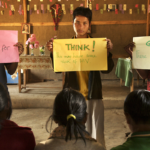Evidence on the health and social benefits of handwashing is strong. We know that handwashing can prevent up to 40% of diarrheal diseases, and can lead to fewer school absences and increased economic productivity. However, many people don’t wash their hands at critical times, even when handwashing facilities are available. While research on behavior change has shown examples of approaches that lead to increased rates in handwashing, we’re still seeking to understand why people wash their hands, and how motivation for handwashing can be translated into programs that result in effective behavior change.
In celebration of Global Handwashing Day on October 15, USAID and the Global Handwashing Partnership – an international coalition with a Secretariat hosted by FHI 360 – organized a webinar on drivers for handwashing behavior change. The Partnership’s work focuses on promoting handwashing with soap as key to health and development, with an emphasis on connecting practitioners with research findings to inform their work. Our webinar speakers provided two examples of how research is exploring behavior change from cognitive (how we think about and understand handwashing) and automatic (how we can be unconsciously prompted to wash our hands) standpoints. In this blog post, I’ll summarize how the two examples show different ways of understanding human behavior and discuss how the findings help us understand what drives behavior change for handwashing.
In our first research example, Prof. Dr. Hans Mosler, Professor of Social Psychology at the University of Zurich and the Group Leader for Environmental and Health Psychology at EAWAG, presented his work using the RANAS model to determine behavior change approaches for handwashing. The RANAS model looks at individual risks, attitudes, norms, abilities, and self-regulation around behaviors. Mosler and his colleagues developed and implemented a survey on handwashing behavior in rural Zimbabwe that was framed around the elements in the RANAS model. The research team conducted qualitative interviews to understand drivers for barriers to handwashing, including contextual factors like availability of handwashing facilities, and psychosocial factors like social norms or beliefs about the benefits of handwashing.
In our second research example, Dr. Reshmaan Hussam presented a randomized control trial that leveraged a different motivation – habit formation and nudging – for handwashing behavior at mealtime. Dr. Hussam and her colleagues based their intervention on the ideas of habit formation, when a behavior becomes easier after repetition, and rational habit formation, in which an individual consciously develops a habit to their own future behavior. The study sample of 2,900 households in rural West Bengal, India, was randomized into incentive and monitoring arms. All households were provided with a dispenser that measured handwashing, a year’s supply of soap, and a calendar to track behavior. Incentive households also received tickets for prizes based on handwashing behavior. Both incentive and monitoring households were further stratified with some groups being told to anticipate additional incentives or monitoring, and some receiving additional monitoring or incentives as a surprise.
Both webinar presenters agreed that a major takeaway from their research was the need to understand the community in which behavior change will take place, and cautioned that neither study was intended to be replicated without careful contextualization. These studies shed light on the complex drivers of handwashing behavior, and illuminate two examples of how to use those drivers to develop interventions. While research may never be able to provide a ‘one size fits all’ approach to behavior change, it can shed light on the factors that motivate handwashing and other behaviors.
To watch the webinar, view presentations, and read the articles presented, visit our summary page here. Global Handwashing Day, on October 15th, is an important opportunity to celebrate, promote, and advocate for handwashing with soap. Visit www.globalhandwashingday.org to get involved.
Photo credit: USAID, courtesy of the Global Handwashing Partnership



